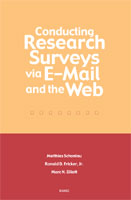 |
Conducting Research Surveys via E-mail and the Web
Matthias Schonlau, Ronald D. Fricker, Jr., Marc N. Elliott
 $22.00
(paperback, 118 pp.)
$22.00
(paperback, 118 pp.)
ISBN: 0-8330-3110-4
MR-1480-RC,
© 2001
All materials below are free, downloadable PDF files.
You will need Adobe
Acrobat Reader to view them.
Contents
Preface
Figures
Tables
Summary
Acknowledgments
Acronyms
Chapter One: INTRODUCTION
Chapter Two: BACKGROUND ON THE SURVEY PROCESS
The Survey Process as a Whole: The Basic Steps
Contact, Response, and Follow-up Modes
Probability and Convenience Samples
Important Considerations in Planning a Survey
Chapter Three: LITERATURE REVIEW OF WEB AND E-MAIL SURVEYS
A Brief History of Electronic Surveys
Response Rates of Internet Surveys
Cost of a Web Survey Versus Other Modes
Comparing Speed and Timeliness of Internet Surveys with Other Modes
Sources of Error with Internet Surveys
Data Quality in E-Mail Versus Mail Surveys
Chapter Four: CHOOSING AMONG THE VARIOUS TYPES OF INTERNET SURVEYS
Convenience Sampling Approaches
Probability Sampling Approaches
A Hybrid Sampling Approach: Combining a Convenience Sample with a Probability Sample
Summary
Chapter Five: GUIDELINES FOR DESIGNING AND IMPLEMENTING INTERNET SURVEYS
Questionnaire Design
Automation
Fielding
Chapter Six: INTERNET SURVEY CASE STUDIES
A Survey Using a Probability Sample of a Closed Population
An Inexpensive Web Survey with a Convenience Sample
A Survey with a Probability Sample of a General Population and Multiple Response Modes
A Survey by a Commercial Web Survey Firm Using a Convenience Sample Adjusted for Self-Selection
Two Surveys Using Probability Samples from Closed Populations
Chapter Seven: CONCLUSIONS
The Future of Internet-Based Survey Methods
Considerations in Employing the Internet for Research Surveys
Addressing Claims About the Current Performance of Internet Surveys
Some Unanswered Questions About Internet Surveys
Appendix
A. LITERATURE REVIEW OF RESPONSE RATES
B. SUMMARY OF EVIDENCE IN THE LITERATURE
C. HOW EFFECTIVE IS USING A CONVENIENCE SAMPLE TO SUPPLEMENT A PROBABILITY SAMPLE?
References
Copyright © 2001 RAND
This
research in the public interest was supported by RAND, using
discretionary funds made possible by the generosity of RAND's donors,
the fees earned on client-funded research, and independent research and
development (IR&D) funds provided by the Department of Defense.
All rights reserved. Permission
is given to duplicate this on-line document for personal use only,
as long as it is unaltered and complete. Copies may not be duplicated
for commercial purposes.
RAND is a nonprofit institution that helps improve policy and
decisionmaking through research and analysis. RAND's publications
do not necessarily reflect the opinions or policies of its research
sponsors.
|
|

Summary:
Internet-based surveys, although still in their infancy, are becoming
increasingly popular because they are believed to be faster, better,
cheaper, and easier to conduct than surveys using more-traditional
telephone or mail methods. Based on evidence in the literature and
real-life case studies, this book examines the validity of those claims.
The authors discuss the advantages and disadvantages of using e-mail and
the Web to conduct research surveys, and also offer practical
suggestions for designing and implementing Internet surveys most
effectively.
Reviewers' Comments
|
|
